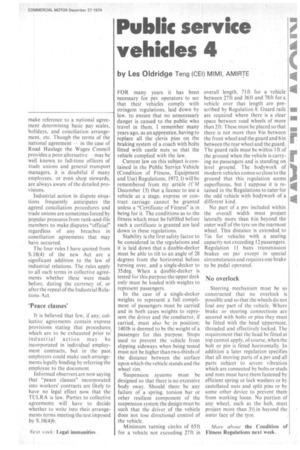Public service vehicles 4
Page 31

If you've noticed an error in this article please click here to report it so we can fix it.
by Les Oldridge Teng (CEI) MIMI, AM1RTE
FOR many years it has been necessary for psv operators to see that their vehicles comply with stringent regulations, laid down by law, to ensure that no unnecessary danger is caused to the public who travel in them. I remember many years ago, as an apprentice, having to replace all the clevis pins on the braking system of a coach with bolts fitted with castle nuts so that the vehicle complied with the law.
Current law on this subject is contained in the Public Service Vehicle (Condition of Fitness, Equipment and Use) Regulations, 1972. It will be remembered from my article (CM December 13) that a licence to use a vehicle as a stage, express or contract carriage cannot be granted unless a "Certificate of Fitness" is in being for it. The conditions as to the fitness which must be fulfilled before such a certificate is granted are laid down in these regulations.
Stability is the first safety factor to be considered in the regulations and it is laid down that a double-decker must be able to tilt to an angle of 28 degrees from the horizontal before turning over, and a single-decker to 35 deg. When a double-decker is tested for this purpose the upper deck only must be loaded with weights to represent passengers.
In the case of a single-decker weights to represent a full compliment of passengers must be carried and in both cases weights to represent the driver and the conductor, if carried, must also be in position; 140 lb is deemed to be the weight of a passenger for this purpose. Stops used to prevent the vehicle from slipping sideways when being tested must not be higher than two-thirds of the distance between the surface upon which the vehicle stands and the wheel rim.
Suspension systems must be designed so that there is no excessive body sway. Should there be any failure of a spring, torsion bar or other resilient component of the suspension system the design must be such that the driver of the vehicle does not lose directional control of the vehicle.
Minimum turning circles of 65ft for a vehicle not exceeding 27ft in overall length, 71 ft for a vehicle between 27 ft and 36ft and 78ft for a vehicle over that length are prescribed by Regulation 8. Guard rails are required where there is a clear space between road wheels of more than 2ft. These must be placed so that there is not more than 9 in between the front wheel and the guard and 6in between the rear wheel and the guard. The guard rails must be within 1 ft of the ground when the vehicle is carrying no passengers and is standing on level ground. The bodywork of modern vehicles comes so close to the ground that this regulation seems superfluous, but I suppose it is retained in the Regulations to cater for the odd vehicle with bodywork of a different kind.
• No part of a pm/ included within the overall width must project laterally more than 6 in beyond the outer wall of the tyre on the rearmost wheel. This distance is extended to 7 in for vehicles with a seating capacity not exceeding 12 passengers. • Regulation Ii bans transmission brakes on psv except in special circumstances and requires one brake to be pedal operated.
No overlock
Steering mechanism must be so constructed that no overlock is possible and so that the wheels do not foul any part of the vehicle. Where brake or steering connections are secured with bolts or pins they must be fitted with the head uppermost, threaded and effectively locked. The requirement that the head be fitted at top cannot apply, of course, when the bolt or pin is fitted horizontally. In addition a later regulation specifies that all moving parts of a psv and all parts subject to severe vibration which are connected by bolts or studs and nuts must have them fastened by efficient spring or lock washers or by castellated nuts and split pins or by some other device to prevent them from working loose. No portion of any wheel, such as the hub, must project more than 31/2 in beyond the outer face of the tyre.
More about the Condition of Fitness Regulations next week.




































































